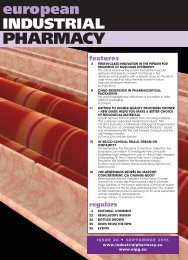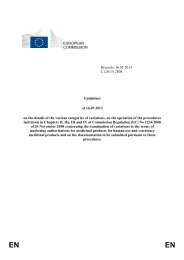PHARMACY
eip31-dec16
eip31-dec16
You also want an ePaper? Increase the reach of your titles
YUMPU automatically turns print PDFs into web optimized ePapers that Google loves.
REGENERATIVE MEDICINE: ENERGISING TECHNOLOGY EVOLUTION TOWARDS FUTURE MEDICINE<br />
continued<br />
Table 1: Key Innovations in the regenerative medicine sphere reflecting technology synergy approaches<br />
Innovation Brief description Therapeutic areas Industry players<br />
Autologous cells Autologous cells, potentially injected • Diabetes mellitus, through bone e.g. co.don AG;<br />
generation for directly into damaged regions of the marrow stem cell transplantation or ZioPharm; Lonza;<br />
transplantation organ or used in regenerative tissue microencapsulated islet cells using Miltenyi Biotec;<br />
patches, have the advantage of avoiding novel biomaterials TotipotentRX;<br />
rejection and, hence, costly • Heart muscle regeneration after Cytomatrix;<br />
immunosuppressive regimens myocardial infarction and TransTissue;<br />
cardiomyopathy<br />
NantKwest<br />
• Tissue-engineered skin substitutes<br />
using autologous stem or progenitor<br />
cells used in skin loss conditions, such<br />
as burns, wounds and diabetic ulcers<br />
Human Treatments based on transplants of • Parkinson’s disease e.g. Asterias<br />
oligodendrocyte human oligodendrocyte progenitor cells • Alzheimer disease Biotherapeutics;<br />
progenitor cells have demonstrated the potential to • Neuroscience Cartherics<br />
transplantation replace or remodel nerves, and even<br />
myelin, and, eventually, contribute to<br />
axonal regeneration in traumatic injuries<br />
Monoclonal Regenerative medicine approaches are • Multiple sclerosis e.g. SIWA<br />
antibodies not focused solely on repairing or • Cancer immunity Corporation; Abnova<br />
enlistment to slow/ replacing tissues and organs, but also • Autoimmune disease<br />
reverse senescence on slowing or reversing biological • Rare and genetic diseases<br />
processes related to aging or<br />
degenerative damage<br />
3D bioprinting 3D bioprinting ultimate goal is the • Eye diseases e.g. Organovo;<br />
for use in drug printing of tissues and cells to develop • Cartilage, skin, and bone BioBots; Cyfuse<br />
discovery and entire human organs, expecting to have regeneration Biomedical; Aspect<br />
medical research the greatest impact in life sciences by Biosystems; 3D<br />
allowing the design and creation of<br />
Bioprinting Solutions;<br />
tissues for drug discovery and medical<br />
Rokit<br />
research<br />
$20 billion by 2020 at a compound<br />
annual rate of 10%.<br />
Rosenthal and Badylak 9 associate<br />
the challenges and opportunities for<br />
regenerative medicine applications<br />
based on three leading research<br />
trends aiming to uncover new<br />
personalised and precision<br />
intervention using regenerative<br />
medicine approaches. First, an<br />
assessment of the molecular<br />
heterogeneity of patient immune<br />
responses to provide vital clues to<br />
the progression of disease and<br />
prompt design of personalised<br />
therapies. Second, a multidisciplinary<br />
environment for the<br />
clinical delivery of regenerative<br />
therapies that engage clinical<br />
research centres with a broad focus<br />
on regenerative medicine. Crucial<br />
for the safe delivery of exogenous<br />
cells, such centres should entail a<br />
substantial degree of infrastructure<br />
in terms of cell growth, advanced<br />
biomaterials, high-resolution clinical<br />
imaging and access to clinical trials<br />
compliant facilities. Third, functional<br />
imaging advances to assess tissue<br />
improvement, and complementing<br />
metabolic signatures, along with<br />
precision medical approaches to<br />
scan individual genetic variations.<br />
How clinical translation is<br />
being advanced worldwide<br />
beyond stem cells<br />
During the past decade, a number<br />
of therapies have received US Food<br />
and Drug Administration clearance<br />
or approval and are commercially<br />
available, demonstrating generally<br />
successful results. The commercialisation<br />
milestones achieved have<br />
been reviewed 10,11 . However, the<br />
promise of regenerative medicine<br />
must translate clinically for<br />
measurable progress to be<br />
achieved. With this objective, in<br />
2014, several initiatives focused on<br />
new pathways for regulatory<br />
approval were initiated.<br />
The introduction of the Early<br />
Approval System (EAS) in the<br />
Japanese regulation, including its<br />
condition of post-market<br />
surveillance, has revolutionised the<br />
industry, remarkably impacting<br />
therapeutics cycle development.<br />
Japan is presently in the spotlight,<br />
significantly attracting business in<br />
the field. Under the new regulation,<br />
companies will be able to perform<br />
clinical research more cost- and<br />
time-effectively in Japan, enabling<br />
the reduction of the full cost of each<br />
therapeutic product discovery and<br />
development by 50% with the<br />
introduction of the EAS. The safety<br />
standards call for testing iPSC for<br />
signs that they may turn cancerous.<br />
As a pilot proof, the Kansai area will<br />
also introduce EAS in the field of<br />
medical devices. Under the scheme<br />
of the Safety Act for Regenerative<br />
Medicine, medical institutions are<br />
allowed to outsource cell<br />
development and processing<br />
operations to external organisations.<br />
The normative has also impacted<br />
the research funding scheme, which<br />
demanded the establishment of an<br />
Independent Administrative Agency<br />
of the Japan Agency for Medical<br />
20 european INDUSTRIAL <strong>PHARMACY</strong> December 2016 • Issue 31





